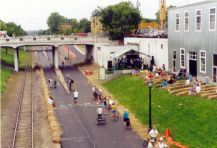Xcel’s Hiawatha Project in MinnPost
February 8th, 2009
This article was in MinnPost on Friday, somehow I missed it — Steve Berg did a great job spelling it all out. Perhaps Xcel will get the message that they’ve really screwed up and need to do this differently?
Here’s the referenced Minneapolis City Council Health, Energy and Environment Committee’s Resolution:
And here’s Steve Berg’s article in toto:
Power lines over the Midtown Greenway? A classic case of destroying a place to save it
